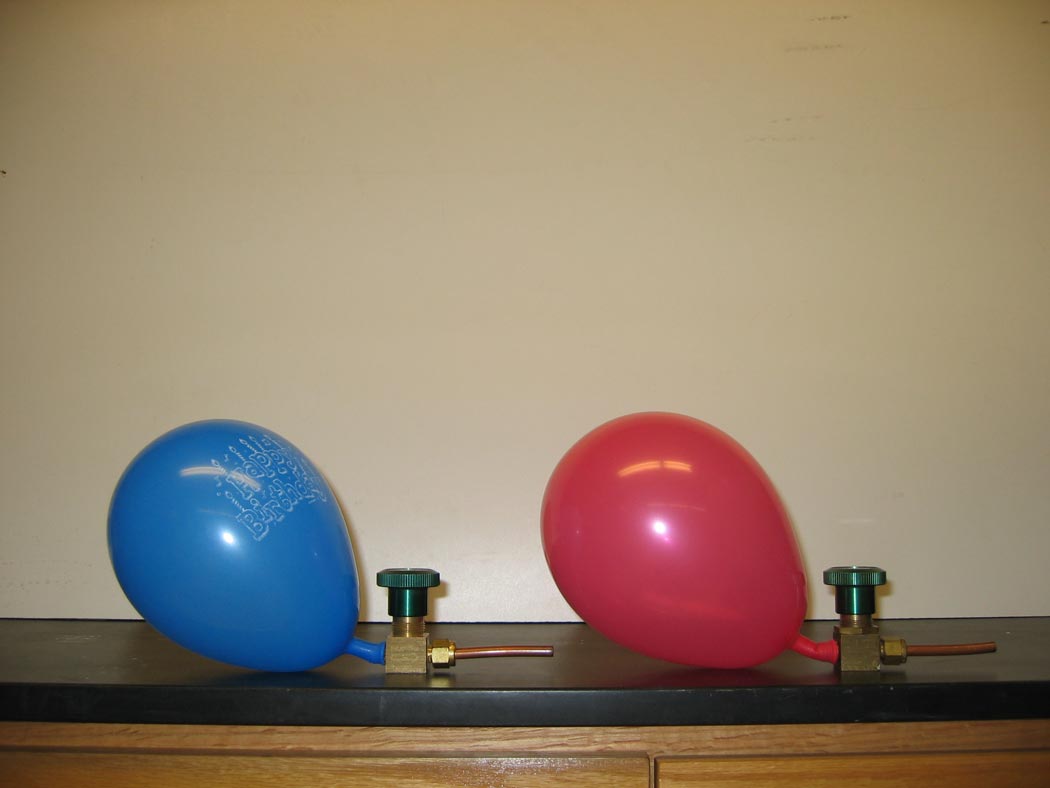The rate of effusion and the effect of mass
 Two balloons are filled with equal volumes of two different gases. When the gases are released, one balloon empties quickly will the other takes it time.
Two balloons are filled with equal volumes of two different gases. When the gases are released, one balloon empties quickly will the other takes it time.
Ingredients: two balloons, two gases, two valves
Procedure: A complete recipe follows.
1. Place two different gases in two separate balloons.
2. Attach the balloons to valves with regularly sized "holes" for the gas to pass through.
3. Release the gas in each balloon, carefully measuring the time for escape of the gas.
Understanding: The ideal gas law was used to accurately represent the properties of gases on the macroscopic scale of Avogadro's number of atoms, NA. The microscopic kinetic molecular theory of matter tells us that a simple gas is composed of atoms, and that the temperature of a gas is intimately related to the average speed of the atoms
uave = (8 RT/ π M)1/2 = (8 kBT/ π m)1/2
where T is the temperature, M is the atomic molar mass, and R is the universal gas constant. The result is also expressed using the atomic mass, m=M/NA, and Boltzmann's constant, kB = R/NA, which is the universal gas constant "per atom."Most fundamentally, the universal gas constant is Boltzmann's constant "per mole." The definition of Avogadro's number has changed over the years. It was once the number of molecules of hydrogen in exactly one gram of hydrogen-1. It was once the number of atoms of oxygen in exactly one gram of oxygen-16. Now it is the number of atoms in exactly twelve grams of carbon-12. Avogadro's number is a convenient counting number determined by humans. When the value of Avogadro's number changes, the value of R changes. But the value of Boltzmann's constant, kB, is a fundamental constant determined by nature.
The result provides a very powerful scaling law, telling us that the average speed of the atoms in the gas will vary as the square root of the temperature
uave ∝ T1/2
It also states that the average speed of atoms in the gas will vary as the inverse square root of the massuave ∝ 1/M1/2
In the demonstration, the release of the two gases, oxygen and hydrogen, was timed. We know that the time required to escape from the balloon will be inversely proportional to the average speed of the molecules. If you double the average speed, the molecules will escape in half the time. We also know that the average speed varies as the inverse of the square root of the mass. So we findescape time for O2 / escape time for H2 = uaveH2 / uaveO2 = (MO2 / MH2)1/2
The molar mass of dioxygen is 32 g/mol and that of dihydrogen 2 g/mol. The result is that we estimate a difference in the escape times of a factor of four, which is what is observed.Identifying the molar mass of a gas by effusion
Question: Someone gives you a balloon with a pure but unknown gas and asks you to identify it. Recalling the results of the molecular kinetic theory, you develop a plan to identify the unknonwn gas.You find a source of dioxygen gas. You prepare a balloon containing dioxygen gas that has the same volume, temperature, and pressure as the balloon containing the unknown gas. You release the gas from each balloon and record the time required for the gas to escape. In the case of dioxygen, the gas requires 47.3 seconds to escape. The unknown gas requires 95.8 seconds to escape.
Determine the molar mass and identity of the unknown gas.
You can check your answers here.